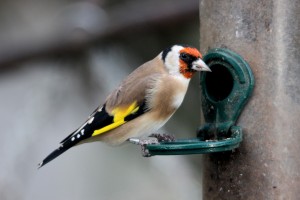 One interesting aspect of feeding birds in gardens is that some people record the type and numbers of birds coming in each day. For many years the British Trust for Ornithology have gathered such information under two of their ongoing surveys. Various trends have been noticed such as the siskins mentioned in this column recently and the latest concerns the blackcap and the nuthatch. Many people have occasional blackcaps coming into their gardens in the winter months and it has long been considered that these birds are from central Europe. Normally these birds would have migrated to their usual wintering grounds in southern Spain but, increasingly, they seem to have started wintering in the UK, including the Highlands. For many years it has been unclear why this change has happened but now the BTO have analysed the records of very many people from their gardens. It shows that blackcaps have increasingly been attracted to feeders in gardens. It seems remarkable that this warbler is an insect feeder in the summer months yet has the ability to change to a diet of seed in the winter months. If you see a blackcap it gets its name from the patch of black feathers on the cap of the male as the female’s cap is reddish-brown.
One interesting aspect of feeding birds in gardens is that some people record the type and numbers of birds coming in each day. For many years the British Trust for Ornithology have gathered such information under two of their ongoing surveys. Various trends have been noticed such as the siskins mentioned in this column recently and the latest concerns the blackcap and the nuthatch. Many people have occasional blackcaps coming into their gardens in the winter months and it has long been considered that these birds are from central Europe. Normally these birds would have migrated to their usual wintering grounds in southern Spain but, increasingly, they seem to have started wintering in the UK, including the Highlands. For many years it has been unclear why this change has happened but now the BTO have analysed the records of very many people from their gardens. It shows that blackcaps have increasingly been attracted to feeders in gardens. It seems remarkable that this warbler is an insect feeder in the summer months yet has the ability to change to a diet of seed in the winter months. If you see a blackcap it gets its name from the patch of black feathers on the cap of the male as the female’s cap is reddish-brown.
The attractive nuthatch has it’s own story to tell but, as with many other garden visitors, its life cycle revolves around the seed in the wider countryside. Up until this year, the last two years have shown a good natural harvest of seed but this year all the signs are that it is a poor year. This means that more and more birds will have to visit gardens for food and there are already signs of this in that there are more records for nuthatches in southern gardens than ever before. This could well mean that nuthatches will continue their slow spread north indicated by the few records in recent years. Surely it cannot be long before this remarkable bird, with its unusual blue grey plumage, will start to breed up here. The spread of nuthatches into the Highlands could have been helped by the extensive woodland on the sides of Loch Ness, particularly the north side. What has also helped has been the more enlightened policy of some landowners in growing deciduous trees of mixed ages. They prefer natural holes for breeding but if these are not available they will utilise artificial nestboxes. Another garden bird to look out for this winter.
Now the latest bird to get particular attention by the BTO will be the goldfinch which many of us get regularly to feeders in our gardens. People will be asked details about the behaviour and numbers of these charming birds during this winter. Interestingly, I have been seeing flocks of goldfinches feeding on the sides of narrow country roads lately. As they rise from the thistles you can see why such flocks are called “charms” as the gold feathers flash in the sunlight. The reason is that roadside verges have not been cut anywhere near as drastically this year so the thistles have had chance to seed. A few years ago we decided to attract goldfinches to natural food in the garden, apart from the usual feeders at the three feeding stations. So we planted teasel seeds and the crop was superb and even attracted butterflies including painted ladies. However, no goldfinches went anywhere near them. The reason, I found out later, is that teasels do not grow wild in the Highlands, only from introductions or escapes from gardens. So the resident goldfinches would not have known how to tackle the new food source.
Tags: highland birds
